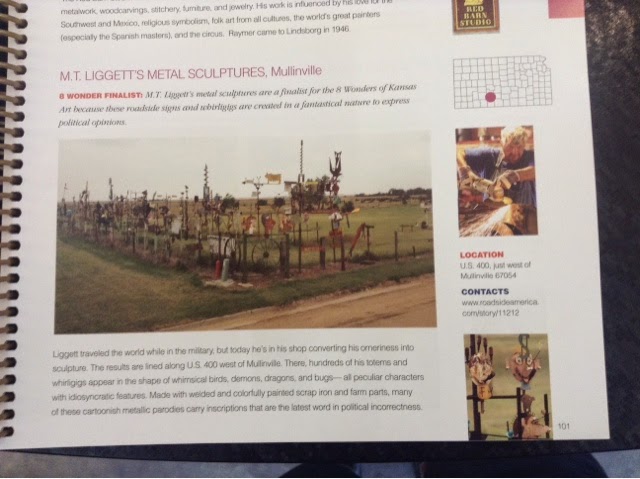When I came upon a vast array of eccentric metal figures lining highway 400 to the west of the small town of Mullinville, it was obvious that this was a notable creation, but it wasn't until I stopped in Greensburg, eight miles down the road did I learn it had been designated one of the twenty-four "Artistic Wonders of Kansas". No one I talked to in Mullinvale expressed any enthusiasm for it, rather just shaking their heads more in scorn than in pride over this "Wonder."
No one cared to give its creator, M. T. Liggett, a word of praise. One woman described him as having "a screw loose." Another called him an ornery old man who always hassled her when he came into her business. The proprietor of the town's service station said he had asked him to provide pamphlets describing his work, as people were always asking about it. He didn't care to, as he said they'd just blow away.
But when I asked the woman looking after the visitor center in Greensburg down the road, she hauled out a book listing all the wonders of Kansas and opened it to the page devoted to Liggett. Greensburg was at the forefront of the book, as its "Big Well," the world's largest hand-dug well, had been designated as one of the top Eight Wonders of the state. It was 109 feet deep and 32 feet wide and had been dug in 1887 to provide water for the railroad. It had also served as the town's source of water until 1932. The new visitor center had been built over it and one could walk down in to it.
The book broke the wonders into nine categories of twenty-four each with eight top wonders and then sixteen honorable mentions. The categories were Overall, Architecture, Art, Commerce, Cuisine, Customs, Geography, History and People. Among the people were Amelia Earhart, George Washington Carter, James Naismath and Buster Keaton. The visitor center also had a map of the locations of the 216 Wonders with clusters in Wichita, Kansas City and Topeka. All of a sudden I have much more than Carnegie Libraries to search out. It was a big surprise though that not one of the fifty-two still standing Carnegies made the list, even though forty-two of them are on the Department of Interior's Registry of National Historic Places.
The last I'd seen in Dodge City, now an art museum, was a particularly exemplary building, highlighted by a dome and stained glass windows and a striking corner location on brick-lined streets. Behind it was a small garden with benches donated by the founder of the town's newspaper, The Daily Globe, whose offices were next door. It had to be the equal of various mansions and churches and hotels and court houses that had made the "Wonders" list. The Carnegies en masse warrant recognition as a general category, just as there is a category of Old-Fashioned Soda Fountains and another of Post Office Section Art scattered around the state. Hell, a Ball of Twine in Cawker City made the list as did a Shoe Tree in Wetmore and the Widest Main Street in the US in Plains.
Greensburg merited top billing on the list not only for its Well, but also for its recovery from one of the fiercest, most powerful tornadoes in history that struck the town in 2007 destroying 95 per cent of its homes and businesses and all four of its churches. Remarkably, only twelve people were killed, including a state trooper in his car. The seventy-year old lady at the visitor center lived through it. It struck just after dark and only lasted fifteen minutes, including a short lull when the eye of the tornado passed by. The roof of her house blew away as she huddled in a hallway with her cats. It was the only tornado she had ever experienced, as the last to hit Greensburg was in the 1920s.
The town has entirely been rebuilt with many solid brick buildings, most with an emphasis on green technology utilizing the incessant winds to provide energy and collecting rain water and making use of natural daylight. Its new hospital is the first LEED Platinum Certified Critical Access Hospital in the United States. The town was a contrast to many of the small towns I have passed through with most of the small businesses on their Main Street boarded up. As I loaded up on hotcakes in one small town, several ladies at a nearby table bemoaned that their town was dying. Its bowling alley had recently closed down and now there were rumors that the country club was going to close as well.






No comments:
Post a Comment